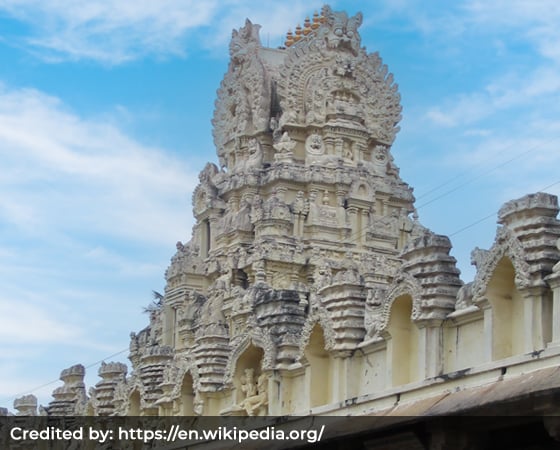Melukote Temple
Click the 'Play' button to read out loud this webpage content
Introduction to the Melukote Temple
Cheluvanarayana Swamy Temple, or Melukote Temple, an ancient religious site in Mandya district, Karnataka. Thirunarayanapura, another name for the Melukote Temple, lies on the small Yadavagiri (Yadugiri) hills overlooking the Cauvery valley. During the patronage of Mysore Wodeyars, the temple flourished. The visit of Sri Ramanujacharya, a renowned Vaishnava Saint, also brought more importance to Melukote Temple. The presiding deity is Cheluvanarayana Swamy, also known as Tirunarayana, a form of Vishnu. The temple lies 156 km from Bangalore and 48 km from Mysore.

History of the Melukote Temple
Utsavamurthy, the metal statue of the presiding deity, was lost during the Mughal invasion. Then Saint Ramanujacharya obtained the idol from Bibi Nachiyaar, Mohammed Shah's daughter.
She had received the idol as a toy. However, she started worshipping the deity instead of playing with it. Mohammed Shah gave the idol back to Ramanujacharya. Then, Bibi Nachiyaar came from Delhi to Melukote in search of it. Soon after seeing the idol, she died.
It is believed that her soul united with the idol as Jyoti. To honour her devotion, her idol was placed next to the feet of the main deity's idol.
The Architecture of the Melukote Temple
The Melukote Temple is one of the famous architectural wonders in Karnataka. It features the Dravidian architectural style. A dome-like top with intricate sculptures of deities, ancient pillars, and carvings are evidence of its artistry.
Pilgrims can see a large pond named Kalyani Theertha near the temple's main steps. This stone pond has a stepped-well shape. Visitors who come to see the pond can lean and rest on the arched pillows of the block-shaped stone steps. Adjacent to the pond, devotees can rest in the huge Bhuvaneshwari Mandap.
The Melukote Temple has a triangular tower (Gopuram). Its main entrance has pillared structures with another Gopuram designed on top of it.
The sanctum sanctorum (Garbhagriha) is a square area from where the main deity Cheluvaraya blesses his devotees. Utsavamurthy is in the form of a small metal idol. There is a pillared corridor in the interior wall section of the sanctorum. Intricately carved sculptures beautify it. There is a belief that Rama and his son Kusha worshipped the Utsavasmurthy, and the deity is also called Ramapriya.
According to mythology, this temple is known as Narayanadri, Vedadri, Yadavadri, Yathishaila, and Tirunarayanapura.
The shrines of Vaikuntanatha, Chakrathalwar, and Anjaneya line the corridors. Yadugiri Nachiyar and Kalyani Nachiyar have separate shrines in the sculptured mandapa. The idol of Sri Ramanuja in this temple has more significance. There are several Vaishnava mutts around the Melukote Temple.
There is an exclusive temple dedicated to Yoga Narasimha on the hill itself. According to the Puranas, it is believed that Prahlada installed the idol of the deity. Krishnaraja Wodeyar III gifted a gold crown to the Yoga Narasimha temple. The deity Yoga Narasimha is almost 3 feet tall and has gold hands and feet, and wears a gold crown.
The Melukote Temple has inscriptions written in Old Kannada, indicating that it is around 1000 years old and that the deity was known as Ramapriya. One of the inscriptions mentions the name of Raja Wodeyar, belonging to the Wodeyar dynasty. The Wodeyar dynasty ruled Mysore between 1399 and 1947. It is the only royal family that has ruled a kingdom for over 500 years. The inscriptions mention that the Mysore King Raja Wodeyar gifted the temple's most valuable jewelry, including two crowns, Vairamudi or Vajramukuta and Krishnaraja-mudi.
The eminent South Indian Vaishnava philosopher and Guru Ramanujacharya lived in Melukote for fourteen years in the 12th century. Soon after that, the town turned into a center of the learned community called Mandyam Iyengars, who were into the research of the Sanskrit language, Vedas, and Indian sciences.
The Melukote Temple premises houses a Sanskrit library and the oldest Sanskrit college named Sri Veda Vedanta Bodhini Sanskrit Mahapathashala, which dates back to 1854. The institution continues to provide instruction in Indian Philosophy and Sanskrit.
Festivals in Melukote Temple
Sri Vairamudi Brahmotsava is one of the major annual festivals celebrated in the Melukote Temple. During this time, the temple conducts a fair for 13 days around the premises in March or April. The deity is adorned with a diamond-studded crown and taken around the Melukote town for a procession. The procession takes place on the 3rd or 4th day of the festival. Over four lakh people attend the Brahmotsava every year.
Vaikunta Ekadashi, Gokulashtami, Diwali, and Rama Navami are other important festivals grandly celebrated in the Melukote Temple.
The Melukote Temple is also known for its delicious puliyogare and payasam prasadam.
Benefits of Worshipping at the Melukote Temple
Taking a holy dip in the Kalyani Theertha is auspicious and believed to cleanse one's sins. Devotees can experience a sense of purification and spiritual rejuvenation by immersing themselves in the holy water.
How to Reach Melukote Temple
By Road
Mandya bus stand is the nearest, which is 40 km away from the temple.
By Rail
Pandavapura is the nearest railway station. It is 25 km away from the temple.
By Air
Mysore Airport, 69 km distance from the Melukote Temple, is the nearest.
Melukote Temple Timings
The Melukote Temple remains open from 7.30 am to 1.00 pm, 4.00 pm to 6.00 pm, and 7.00 pm to 8.00 pm.
If you wish to have customized spiritual tours or pilgrimages arranged in India for yourself or for a group of people, please contact Brindavan Mystic Services
Email ID: [email protected]
Toll free: 1800 102 9098